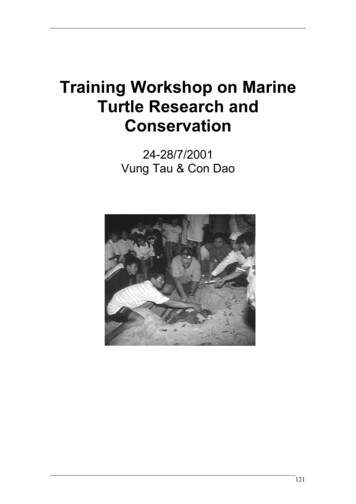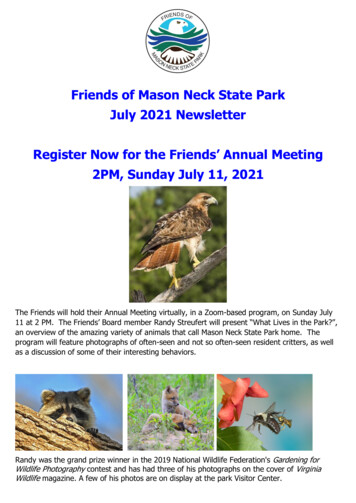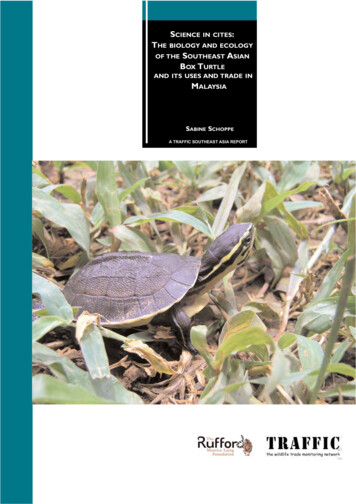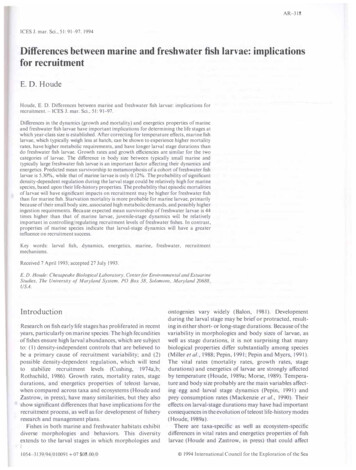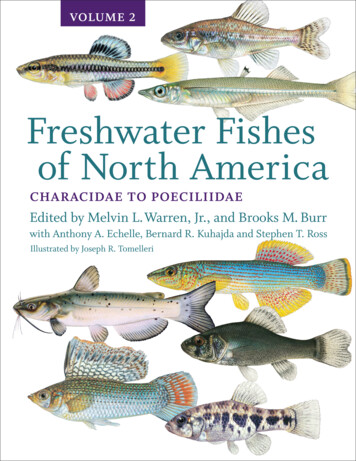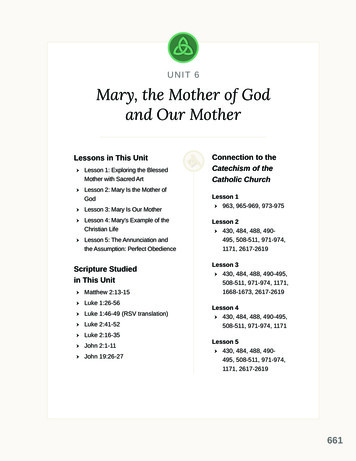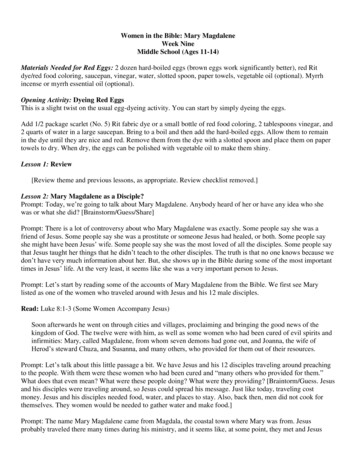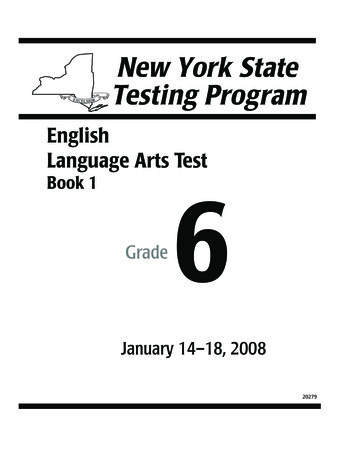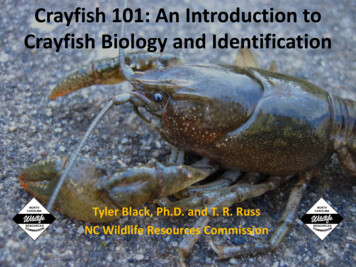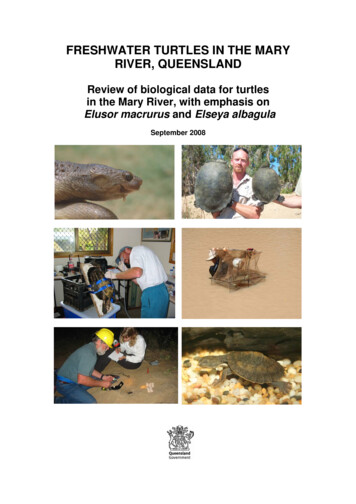
Transcription
FRESHWATER TURTLES IN THE MARYRIVER, QUEENSLANDReview of biological data for turtlesin the Mary River, with emphasis onElusor macrurus and Elseya albagulaSeptember 2008
The State of QueenslandISBN 978-1-7423-0992DisclaimerThis document has been prepared with all due diligence and care, based on the best availableinformation at the time of publication. The department holds no responsibility for any errors oromissions within this document. Any decisions made by other parties based on this document aresolely the responsibility of those parties.If you need to access this document in a language other than English, please call the Translating andInterpreting Service (TIS National) on 131 450 and ask them to telephone Library Services on 61 73224 8412.This publication can be made available in an alternative format (e.g. large print or audiotape) onrequest for people with vision impairment; phone 61 7 3224 8412 or email library@ehp.qld.gov.au .CitationLimpus, Col. 2008. Freshwater Turtles in the Mary River: Review of biological data for turtlesin the Mary River, with emphasis on Elusor macrurus and Elseya albagula. Brisbane: QueenslandGovernment.Prepared in September 2008 (published October 2012).
ContentsExecutive summary.iv1. SPECIES DIVERSITY WITHIN THE MARY RIVER . 12. METHODS . 4Data sources and analysis . 4Capture . 4Distribution . 5Morphological measurements and tagging . 6Sex, maturity and reproductive status. 6Nests, eggs and clutches . 7Age and growth . 8Mortality and injury . 83. MARY RIVER TURTLE, Elusor macrurus. 174. WHITE-THROATED SNAPPING TURTLE, Elseya albagula. 315. KREFFT’S RIVER TURTLE, Emydura macquarii krefftii . 456. CLOACAL VENTILATION. 617. References. 68APPENDIX 1. . 71
Executive summaryThis report was prepared by the former Environmental Protection Agency inSeptember 2008 as part of a review of the knowledge of Mary River turtles capturedwithin the State Government’s Queensland Freshwater Turtle database.The Mary River is an iconic river for Queensland. It has high biodiversity (six species)and high endemicity (two locally endemic species) of freshwater turtles which includeancient lineages of turtles such as the Mary River turtle, Elusor macrurus, and thewhite throated snapping turtle, Elseya albagula, as well as ancient lineages of fishincluding the lungfish, Neoceratados forestii.In the 1960s and early 1970s, Elusor macrurus was subject to a significantpopulation decline because of excessive egg harvest for the pet trade. This pet tradeand associated egg harvest ceased in 1974.The long-term, pervasive and intense loss of eggs on nesting banks throughpredation is the most critical threat to the survival of the two listed freshwater turtlespecies in the Mary Catchment: Elusor macrurus and Elseya albagula. This resultingfailure in recruitment of young turtles to the river has been in progress for at least onegeneration (15-20 years). Unless concerted action is taken to substantially reduceegg loss on the nesting banks and increase hatchling recruitment to the river, thesespecies are unlikely to survive in the long term.Elusor macrurus and Elseya albagula are cloacal ventilating species that rely onaccess to dissolved oxygen within the stream, are restricted to the flowing streamsand shallow waters of large water bodies of the catchment. Small juveniles areidentified as the component of the population that is at greatest risk if in-stream waterquality deteriorates with reduced oxygen availability.There has been limited opportunity to investigate the impact of impoundmentinfrastructure on the health of wild, free-ranging turtles in the Mary River Catchment.Based on present data, the highest frequency of turtles with fractures consistent withhaving been impacted on hard habitat occurs in the vicinity of Borumba Dam. Alower frequency of fractures occurs in populations well removed from impoundmentinfrastructure.The occurrence of persistent Elusor macrurus and Elseya albagula populations insome of the water infrastructure impoundments in the Mary River should be a priorityfor investigation. This will provide better insights into the actual environmentalconditions under which long-term viable populations of Elusor macrurus and Elseyaalbagula can be maintained in a progressively altering catchment.Elusor macrurus and Elseya albagula are characterised by: slow growth of immatures and delayed maturity. First breeding is not expecteduntil they are approximately 15-20 years old; most adult females breeding each year and breeding in successive years; females aggregating to breed at traditional nesting banks; most adult females laying only one clutch of eggs per year; a high hatch success if the eggs are not flooded or preyed upon.These are slow-growing, delayed maturity, low-fecundity species.iv
Elusor macrurus lay their eggs in spring and early summer. Elseya albagula lays itseggs in autumn and early winter and these eggs have a long embryonic diapause.Hatching of eggs for both species occurs during summer in late November to earlyJanuary.Elusor macrurus and Elseya albagula nesting is not uniformly distributed within theMary River. The best nesting aggregations continue to be identified at the traditional nestingbanks near Tiaro. A series of nesting banks supporting a lower density of nesting has beenidentified in the upstream reaches between Traveston and Kenilworth. There are many sand banks along the Mary River that may appear to be“potential” nesting banks to the human eye but which are not used to anysignificant level for nesting by either Elusor macrurus or Elseya albagula.For most investigated sites within the Mary River Catchment there is a deficiency ofimmature turtles in the populations. The populations consist primarily of aging adults,especially for Elusor macrurus and Elseya albagula. For the three species investigated, Elusor macrurus, Elseya albagula andEmydura m. krefftii, there was a general trend for increasing proportion ofimmature turtles in the population with progressive sampling from thedownstream reaches below Tiaro to the upstream reaches near Kenilworth. The species with the poorest representation of immature turtles in the populationswere, in general, the slow-growing, delayed maturity, low-fecundity species. Based on the limited size-class distribution of immature Elusor macrurussampled, there is the possibility that there is a nett upstream movement ofjuvenile turtles from the Tiaro reaches with their associated traditional highdensity nesting aggregations to the mid to upper catchment reaches.Several hypotheses are proposed to account for these observations of immatureturtle distributions:a. There has been an improvement in juvenile recruitment over the past decade;b. There has been better juvenile recruitment in the upper reaches of the Mary Riverthan in the middle to lower reaches, possibly because of active management offeral pests by farmers in the upper catchment;c. Small immature E. macrurus, of about 3-4 years of age, migrate upstream fromthe vicinity of the principal nesting banks near Tiaro and accumulate in the middleto upper stream reaches of the Mary River when more than 4 years old.d. The samples are biased by a combination of study methods and operator skills.Management considerations: Designing effective conservation management for freshwater turtles within theMary River Catchment is hampered by the continuing paucity of biologicalknowledge of these species and their ecological requirements. Loss of eggs through predation on the nesting banks is the most critical threat tothe survival of the two freshwater turtle species in the Mary Catchment, Elusormacrurus and Elseya albagula. Unless concerted action is taken to substantiallyreduce egg loss on the nesting banks and increase hatchling recruitment to theriver, these species are unlikely to survive in the long term. Construction of dams and weirs can be expected to cause some local reductionin suitable habitat for these species and associated reduction in population sizewithin the foot print of the deep water habitats of the impoundment.v
Following the construction of dams and weirs, continued foraging and breedingby E. albagula and E. macrurus can be expected to occur within the slow-flowing,shallow, upstream reaches of impoundments.Construction of a dam should not result in the loss of populations of these turtlesdown stream of the impoundment infrastructure.The water released for stream flow volume and water quality down stream of aninfrastructure is largely determined by the authorities managing the impoundmentand its infrastructure. Therefore, the release of water from impoundments shouldbe managed to enhance the quality of the down stream habitats for thesethreatened turtles.Impoundment infrastructure can cause injury and death of many turtles thataggregate at the infrastructure. Based on lessons learned at existing dams andweirs, through consultation with turtle biologists and engineers, dam/weirinfrastructure design can be made more turtle-friendly to reduce turtle injury andmortality.More studies are required to design a mechanism whereby turtles can movesafely upstream and downstream past impoundment infrastructures.If the survival prospects for these species are improved, there needs to bemanagement actions to improve the riparian vegetation and broader catchmentmanagement, not just within the impoundments.Given the existing significant threat to Elusor macrurus and Elseya albagula frompredation of eggs and the potential for the construction of a major dam to furthernegatively impact on these species, it is considered imperative that a whole-ofCatchment approach be taken for developing a management plan for themaintenance of sustainable populations of freshwater turtles in the Mary RiverCatchment. All existing and potential threats to the species are amenable tomitigation with appropriate planning. Concerted action is needed to develop andimplement an appropriate conservation management plan.vi
1. SPECIES DIVERSITY WITHIN THE MARY RIVERCurrently, eight genera of freshwater turtles from two families occur in Australia:Family Carettochyididae (Carettochelys) and Family Chelidae (Chelodina, Elseya,Elusor, Emydura, Pseudoemydura, Rheodytes and Wollumbinia) (Cann, 1998; Wells,2007). The Mary Catchment, which also has a high diversity of native freshwater fish(Lake, 1971), supports the highest biodiversity of freshwater turtles in Australia withsix species from five genera of the chelid turtles occurring in the catchment (Leglerand Georges, 1993; Cann, 1998) (Table 1). Only the Fitzroy River in centralQueensland has a similar level of species diversity. The Mary Catchment also hasone of highest levels of endemicity of freshwater turtles in Australia with two localisedendemic species, Elusor macrurus and Elseya albagula. E. macrurus is endemic tothe Mary Catchment while E. albagula is endemic to the combined Fitzroy-BurnettMary Catchments. Therefore the Mary Catchment is one of the most significant riversystems in Australia with respect to conservation of biodiversity of Australianfreshwater turtles.These same species, E. macrurus and E. albagula, were identified as critical andhigh priority, respectively, during the government’s Back on Track prioritisationframework for conservation management of Queensland’s wildlife (BOT) in 2006.Both these species of critical and high conservation concern in the Mary Catchmentare relatively new to science: E. macrurus was first described as a new genus and species in 1994 (Cann andLegler, 1994) and few publications on its biology have occurred since then. E. albagula was recently described in 2006 (Thomson et al. 2006). It is one of fivespecies now recognised in the E. dentata species complex that spans coastalnorthern and eastern Australia from northern Western Australia to southQueensland. Few studies addressed the biology of E. albagula prior to 1998.In addition, both are among our more ancient lineages of freshwater turtles (Georgeset al. 2006). These are specialist species with cloacal ventilation (Legler andGeorges, 1993; Cann, 1998; Flakus, 2002; Limpus et al. 2002; FitzGibbon, 1998;Mathie, 2007) and slow growth with delayed maturity, taking 15-20 years before theirfirst breeding (Flakus, 2002; Tucker, 2000; Hamann et al. 2004). These turtle speciesare among those most susceptible to the impacts of habitat change.Like all Australian chelid turtles, the turtles within the Mary River are notcharacterised by temperature dependent sex determination (Georges, 1988;Thompson, 1988; Palmer-Allen et al. 1991). Nest temperatures do not determinehatchling sex ratios for these species. Any population anomalies for these species inthis catchment cannot be attributed to temperature dependent sex determination.In the absence of any pre-and-post construction studies to determine the impact ofdams and weirs on turtle species in the Mary River, we rely on the Tucker (2000)study that indicates that some population change through either loss of habitat orreduction in population size can be expected to occur with each new impoundment.However, studies in the Burnett River (Hamann et al. 2004) and the Fitzroy River(Limpus et al. 2011) and the present evaluation of Mary River turtles indicate that thecloacal ventilating species can continue living and breeding within at least theshallow, up-stream reaches of impoundment areas for decades after theirconstruction.In the absence of any studies of impacts of over-topping events and water releaseevents from dam and weir infrastructures in the Mary River, the Hamann et al. (2007)1
and Limpus et al. (2011) studies in the Burnett and Fitzroy Rivers respectivelyprovide a basis for identifying other likely negative impacts of dam and weirinfrastructures on the health and mortality of turtles: Impoundment structures are barriers to the movement (migration) of turtles upand down the streams. In the long term this has the potential to limit gene flowwithin the population as a whole. No existing fishway has been proven suitable for enabling turtles to pass safelyback and forth past impoundment infrastructures. Some turtles are significantly damaged or killed when they are washed overimpoundment structures with flooding events and smashed on the concrete orrock structures at the base of walls or when they try to climb the walls and fallback onto the concrete or rock footings. Turtles are attracted to and aggregate within the low velocity stream flowsassociated with environmental flows from impoundment structures. Some ofthese same turtles are significantly damaged or killed when they are washedback with high velocity water releases through an impoundment wall, e.g. withagricultural flow releases. Filter systems which prevent trash entering and blocking water release intakes onthe upstream side of impoundment infrastructures can trap large numbers ofturtles and cause their death.Within the current regime of impoundments within the Mary River, there is noindication that the presence of these impoundments threatens the survival of thesespecies further downstream from impoundment structures. However, the concernsraised by Boardman (1996) regarding the potential for cumulative impacts of multipleimpoundments on turtle populations to be non-sustainable should not be ignored inthis regard.It is presumed that land management over the past century-and-a-half within theMary Catchment has had additional negative impacts on these species with reductionof riparian vegetation resulting in a reduction of fruits selected for food (fig, lillypilly,black bean) falling into the water, reduction in large log tangles as refugia andsiltation/infilling of pools. There is a dearth of information on the impact on wild turtlepopulations of pesticide, herbicide, fertiliser and other chemical pollution runoff fromfarms, industry and urban development.During dry seasons, agricultural demand for water is expected to result in the poolsthat are drought refugia for these turtles being drawn down to levels lower that wouldoccur naturally.2
Table 1. Freshwater turtles in the Mary Catchment, south Queensland. Recent taxonomicchanges have separated Elseya latisternum and other closely related species to a newgenus, Wollumbinia (Wells 2007).NameSpeciesMary RiverturtlesElusor macrurusWhite throatedsnapping turtleElseya albagulaSawshell turtleWollumbinialatisternum#Krefft’s shortnecked turtleEmyduramacquarii krefftiiBroad-shelledriver turtleChelodinaexpansaEastern snakenecked turtleChelodinalongicollisEndemicityOccurs only inMaryCatchment, SEQldOccurs in Mary,Burnet & FitzroyCatchments, SEQldWide spread,northern NSW,QLD & easternNTWide spread,Mary River toCape YorkPeninsula, QldWide spread,SA-Vic-NSW-sthQldWide spread,SA-Vic-NSW-sthQld3Threatenedspecies gered,BOT critical-Common,BOT high-Common-Common-Common-Common
2. METHODSData sources and analysisThis report was initially commissioned by Queensland Water Infrastructure to reviewthe knowledge of Mary River turtles captured within the government’s QueenslandFreshwater Turtle database. In response to the initial report, it was requested thatmore information be supplied on the sampling periods, sampling areas and methodsused in gathering these data. This second edition of the report addresses theseissues and has re-organised analysis and discussion of results while including someadditional data gathered over the last year.The study has collated data and summarises the knowledge gained from studies offreshwater turtles within the Mary Catchment. Tagging data from past studies aremaintained within the Queensland freshwater turtle database maintained by thegovernment’s Turtle Conservation Project (QTCP). While no new field data wascollected specifically during the present study, incidental data has continued to berecorded by staff and volunteers within the QTCP. Data has been sourced from thefollowing studies: Cumulative effects of dams and weirs on freshwater turtles: Fitzroy, Kolan,Burnett and Mary Catchments, a QPWS study 1997 to 1999 (Tucker, 2000). S. Flakus M.Sc. studies, University of Queensland (Flakus, 2002). Tiaro community nest protection project (Tiaro and District Landcare Group Inc.2005; Connell and Wedlock, 2006; van Kampen et al. 2003). Turtle studies by the former Environmental Protection Agency (EPA) in the MaryRiver:oDewatering the Borumba Dam plunge pool, collaborate project withSunwater;oTagging-recapture studies in the Mary River collecting comparative E.albagula data for use in Burnett and Fitzroy Catchments studies (Thomsonet al. 2006; Hamann et al. 2007; Limpus et al. 2007).oTurtles supplied to post-graduate studies on E. albagula cloacal ventilation. Turtle studies of turtle mass mortality events by the former EPA. Data from other published studies.New data collected by staff of the former EPA and QTCP volunteers that were addedto the database during 2007-2008 include: Results of vessel based survey of turtle nesting banks along the Mary Riverduring November 2006 from Kenilworth to Tiaro by Greening Australia, Tiaro. Snorkelling capture and tagging study by Craig Latta during April-May 2007 in theMary River upstream of Traveston Crossing. Preliminary investigation of Obi Obi Creek, a mountain stream tributary in theextreme upper Mary River Catchment.For statistical analysis, unless otherwise stated, means are presented with standarddeviations. Statistical significance was accepted at p 0.05.CaptureUnless otherwise defined, the procedures described in Limpus et al. (2002) andHamann et al. (2004) were used for the capture of turtles. Major sampling sitesnamed in the text are shown in Figure 2.1. The sampling sites along the Mary Riverfor which turtle data area available have been grouped into “sampling areas” shownas numbered sections in figure 2.1:4
1. Within the Mary Barrage, downstream from Tairo.2. Tiaro, adjacent to the traditional nesting banks identified by Flakus (2002).3. Upstream and downstream of the highway bridge over the Mary Riveradjacent to the junction with Munna Creek.4. Gunalda reaches.5. Gympie reaches.6. Upstream and downstream of Traveston Crossing.7. Kenilworth area, downstream of Obi Obi Creek junction.Data collected from tributaries are analysed for each of the respective tributaries.The turtle capture data from each sampling area are summarised in Appendix 1.Turtles were captured using four main methods: Snorkelling: Turtles were located visually by snorkelling along the sides andbottom of streams and captured by hand. Most snorkelling was by day (Figure2.2a). Trapping: Various trap designs were used during 1997-2007 within the MaryRiver Catchment.o Submerged trap: The original trap used was a submerged modifiedrectangular collapsible crab pots with two wide funnel openings and with aline to a surface marker.o Floating trap: In some situations, the above collapsible traps were modifiedusing internal styrofoam floats to produce a floating traps.o Cathedral trap #1: Since 2003, the most commonly used trap was the“cathedral trap”. These were modified submerged rectangular collapsibletraps with an additional chamber above that was accessed via a vertical oneway entrance from the lower baited chamber. The trap was deployed so thatthe top of the upper compartment was positioned so that turtles could surfaceto breathe (Figure 2.2b).Submerged traps were checked every 1-2 hours depending on watertemperature. Cathedral traps and floating traps were checked at least twice every24 hours. Throughout this study a single bait type (beef heart) was used becauseof its attractiveness to a wide variety of turtle species and ease of handling. Seine netting: Seine nets 70 m or 30 m long and with mesh size of 5.5 cm wereused singly or in combination in the open water habitats usually less than 2 mdeep (Figure 2.2c). Most seine netting was conducted by day. Muddling: A line of people walking across a shallow pool, usually 50 cm deep,used their hands and feet to locate and catch turtles (Figure 2.2d).Unless stated, each turtle was released at the point of its initial capture.DistributionAn extensive range of habitats throughout the Mary Catchment has been sampled –from large reaches of the main river to farm dams; from permanent river reaches todrying waterholes in streams that do not flow year round. Where required, theAdopted Middle Thread Distance (AMTD) was used to reference capture sites,movement patterns of individual turtles and to describe the position of sites duringthe study. AMTD is defined as the distance, in kilometres, along the midline of thestream from the point of interest to the stream’s mouth or confluence with the mainwatercourse (data was supplied by former Department of Natural Resources andWater). A GPS location (navigation set up WGS84) was recorded directly for each5
capture site or pool or the latitude and longitude for the capture site was estimatedfrom GIS generated maps of the Catchment.Morphological measurements and taggingMorphological measurements were taken as described in Limpus et al. (2002). Twoprimary measurements were analysed during preparation of this report. Straightcarapace length (SCL) was measured along the midline from the anterior end of thecarapace to the posterior margin of the carapace at the junction between the postventral scutes. Tail length to carapace (TC) was the straight distance from the tip ofthe extended tail to the posterior end of the carapace.Turtles captured within the Mary Catchment from 1996 until 2008 have been taggedusing the standard methods used within the government’s Queensland TurtleConservation Project (Limpus et al. 2002). Each turtle was tagged with a self-locking,self-piercing monel tag in the webbing of a hind foot (Figure 2.3a) and/or coded withone or more notches in the marginal scutes (Figure 2.3b).Sex, maturity and reproductive statusLife history stages are defined as follows.Adult is defined as a turtle that is reproductively active for the current breedingseason or one that has bred in the past.Immature is defined as a turtle that has not completed development of itsreproductive system and has not commenced breeding.Hatchling is defined as a recently hatched young still associated with the nest or asa small juvenile turtle captured in the wild with an egg caruncle present and withan incompletely closed umbilical scar (Figure 2.4).To determine gender, sexual maturity and breeding status, gonads were routinelyexamined either visually via laparoscopy following the methods of Limpus et al.(2002) and Hamann et al. (2007) (Figure 2.5a). Some gravid females carryingoviducal eggs were identified by palpation via the inguinal pocket.The structure and development of the gonads and reproductive ducts of chelid turtlesare, in principal, very similar to those previously described for marine turtles (FamilyCheloniidae: Limpus and Limpus, 2003; Limpus, 1992) and have been described inpart by Limpus et al. (2002), Hamann et al. (2007) and Limpus et al. (2011).Females were assigned a maturity status based on ovarian and oviductcharacteristics (After Limpus et al. 2011):Immature: if the oviduct and ovary were not fully expanded (Figure 2.5b) or the ovarydid not contain corpora albicantia, corpora lutea or mature ovarian follicles.Adult: if the ovary contained one or more of the following characteristics; anenlarged, convoluted oviduct and expanded ovary with developing, mature orlarge atretic follicles, corpora lutea or corpora albicantia or oviducal eggs (Figure2.5d,e,f,g). Adult female breeding status was defined using the following criteria: Corpora albicantia are characteristic of females that have ovulated in anyprevious breeding season (Figure 2.5f) Vitellogenic females preparing for the next breeding season had developing,vascularized yellow follicles larger than 0.5 cm in diameter that were distinctlylarger than the previtellogenic follicles (Figure 2.5d).6
A female that had ovulated in the most recent breeding season wascharacterised by corpora lutea on the ovary (Figure 2.5c,d,e,f) and in someindividuals, large ovarian follicles in atresia (Figure 2.5g).Female turtles breeding in consecutive seasons had either oviducal eggs orhealing corpora lutea indicating that they had bred in the most recentbreeding season and developing follicles in the ovary indicating that theywere preparing to breed in the next breeding season (Figure 2.5g).Males were assigned a maturity status based on testicular and epididymischaracteristics (After Limpus et al. 2011):Immature: if the epididymis was not fully distended from the body wall to be apendulous structure adjacent to the testis (Figure 2.6a,b). Testis may be flat toovoid in cross-section (Figure 2.6a).Adults: if they had a fully pendulous epididymis extruding into the body cavity fromthe body wall (Figure 2.6c,d). Adult male breeding status was defined using thefollowing criteria: Adult males within their spermatogenic phase were identified by the presenceof a distinct white tubule in the epididymis (Figure 2.6d). Adult males also had visually distinct seminiferous tubules in the testes(Figure 2.6c).Nests, eggs and clutchesNest sites were located using a range of methods. At nesting time by day, streammargins were searched for tracks of nesting females to and from the water (Figure2.7a). Known nesting banks were searched at night using spotlights to locate turtlesashore on nesting attempts. Some nesting turtles were encountered during daylighthours (Figure 2.7b,c). Stream margins were systematically searched in the vicinity ofsand and loam banks for signs of nest sites and for broken eggshell from nests duginto by predators (Figure 2.7d).Particular emphasis was given to searching stream banks between May and Octoberfor evidence of E. albagula nesting and during October-December for evidence of E.macurus nesting.The nest location was recorded for distance ( 0.01 m) from water, height abovewater ( 0.1 m) and angle of slope of the bank from the water. Nests were excavatedto record depth ( 0.5 cm) to top of eggs and to bottom of eggs. When eggs were inthe nest they were removed with minimum of rotation for counting and each eggweighted on an electric balance ( 0.1g) and measured ( 0.01cm) for length andwidth using vernier callipers (Figure 2.8).When intact or predated clutches were detected for which the nesting female had notbeen observed, species identification of eggs w
The Mary River is an iconic river for Queensland. It has high biodiversity (six species) and high endemicity (two locally endemic species) of freshwater turtles which include ancient lineages of turtles such as the Mary River turtle, Elusor macrurus, and the white throated snapping turtle, Elseya albagula, as well as ancient lineages of fish

